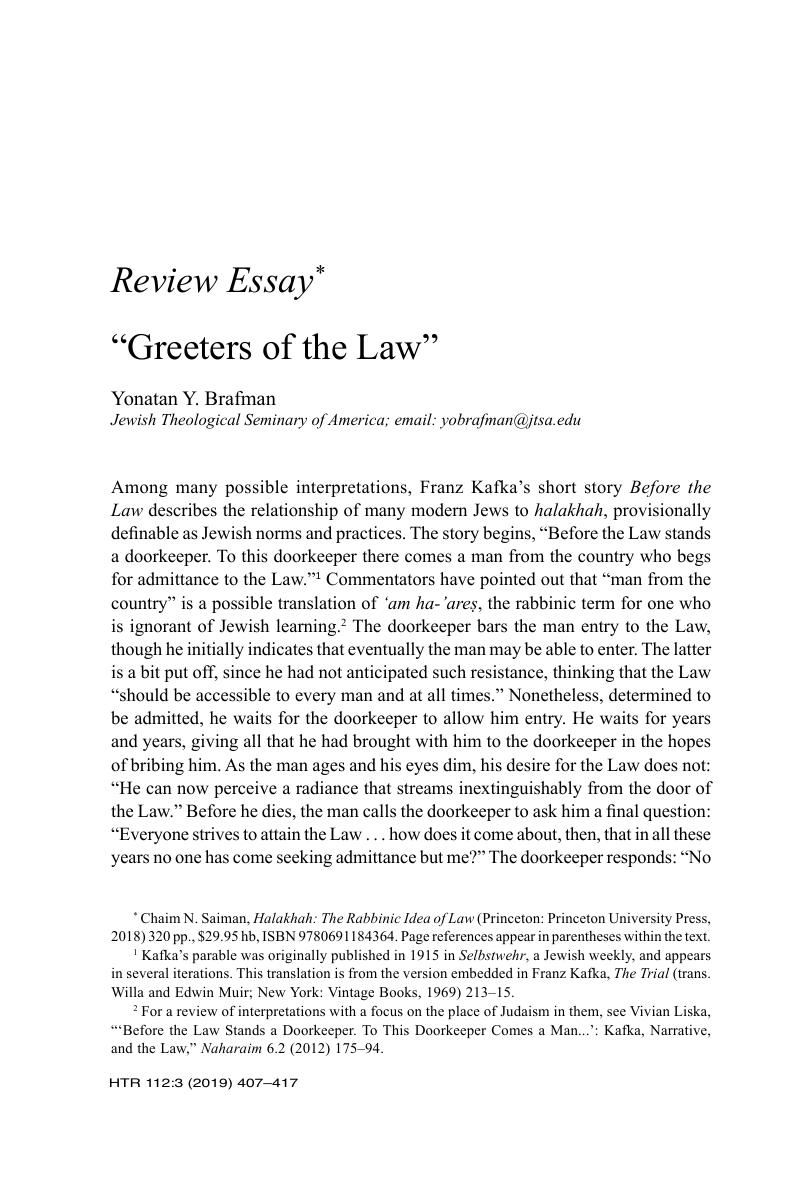No CrossRef data available.
Article contents
“Greeters of the Law”
Published online by Cambridge University Press: 08 July 2019
Abstract

- Type
- Review Essay
- Information
- Copyright
- © President and Fellows of Harvard College 2019
Footnotes
Chaim N. Saiman, Halakhah: The Rabbinic Idea of Law (Princeton: Princeton University Press, 2018) 320 pp., $29.95 hb, ISBN 9780691184364. Page references appear in parentheses within the text.
References
1 Kafka’s parable was originally published in 1915 in Selbstwehr, a Jewish weekly, and appears in several iterations. This translation is from the version embedded in Franz, Kafka, The Trial (trans. Willa, and Edwin, Muir; New York: Vintage Books, 1969) 213–15Google Scholar.
2 For a review of interpretations with a focus on the place of Judaism in them, see Vivian, Liska, “‘Before the Law Stands a Doorkeeper. To This Doorkeeper Comes a Man...’: Kafka, Narrative, and the Law,” Naharaim 6.2 (2012) 175–94Google Scholar.
3 Joseph, B. Soloveitchik, Halakhic Man (trans. Lawrence, Kaplan; Philadelphia: Jewish Publication Society of America, 1983) 137Google Scholar.
4 Ibid., 19–20.
5 Ibid., 24.
6 Eliezer, Berkovits, Not in Heaven: The Nature and Function of Halakha (New York: Ktav, 1983) 71Google Scholar.
7 Ibid., 81.
8 Robert, M. Cover, “Nomos and Narrative,” Harvard Law Review 97 (1983) 11–19Google Scholar.
9 Menachem, Elon, Jewish Law: History, Sources, Principles (4 vols.; Philadelphia: Jewish Publication Society, 1994Google Scholar); An Introduction to the History and Sources of Jewish Law (ed. N.S. Hecht et al.; Oxford: Clarendon Press, 1996).
10 Hart, H. L. A., The Concept of Law (2nd ed.; Oxford: Oxford University Press, 1994Google Scholar).
11 Ronald, Dworkin, Law’s Empire (Cambridge: Belknap Press of Harvard University Press, 1986; repr., Oxford: Hart Publishing, 1998Google Scholar).
12 Ibid., 90, page numbers taken from the reprinted edition.
13 Ibid., 52.
14 Christine, Hayes, What’s Divine about Divine Law? Early Perspectives (Princeton: Princeton University Press, 2017Google Scholar); The Cambridge Companion to Judaism and Law (ed. Christine Hayes; New York: Cambridge University Press, 2017). Full Disclosure: I am a contributor to the latter volume.
15 Richard, Rorty, “Religion as Conversation-Stopper,” Common Knowledge 3.1 (1994) 1–6Google Scholar.
16 Rachel, Adler, Engendering Judaism: An Inclusive Theology and Ethics (Boston: Beacon Press, 1999Google Scholar); Tamar, Ross, Expanding the Palace of Torah: Orthodoxy and Feminism (Hanover, MA: Brandeis University Press, 2004Google Scholar).
17 Cover, “Nomos and Narrative,” 44–60.
18 Robert, M. Cover, Narrative, Violence, and the Law: The Essays of Robert Cover (ed. Martha, Minow, et al.; Ann Arbor: University of Michigan Press, 1995) 175Google Scholar.
19 Adler, Engendering Judaism, 25–26.
20 Ross, Expanding the Palace of Torah, 145–83.


